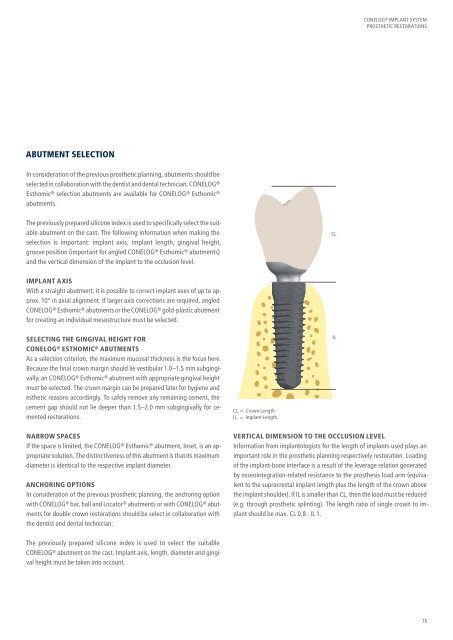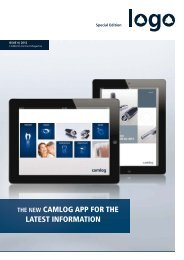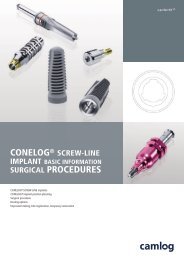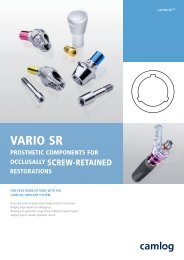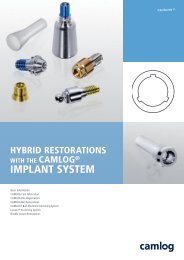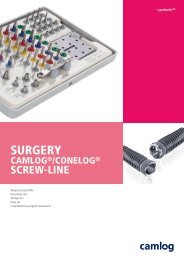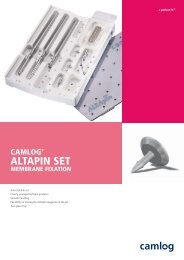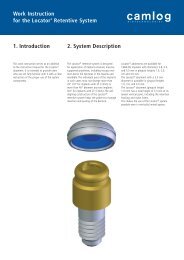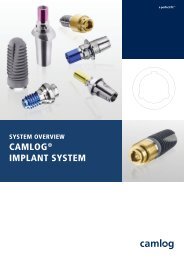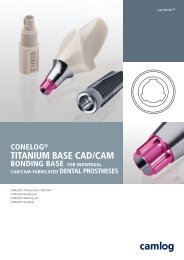CONELOG® Implant System Prosthetic Restorations - Camlog
CONELOG® Implant System Prosthetic Restorations - Camlog
CONELOG® Implant System Prosthetic Restorations - Camlog
You also want an ePaper? Increase the reach of your titles
YUMPU automatically turns print PDFs into web optimized ePapers that Google loves.
ABUTMENT SELECTION<br />
In consideration of the previous prosthetic planning, abutments should be<br />
selected in collaboration with the dentist and dental technician. CONELOG ®<br />
Esthomic ® selection abutments are available for CONELOG ® Esthomic ®<br />
abutments.<br />
The previously prepared silicone index is used to specifically select the suitable<br />
abutment on the cast. The following information when making the<br />
selection is important: implant axis, implant length, gingival height,<br />
groove position (important for angled CONELOG ® Esthomic ® abutments)<br />
and the vertical dimension of the implant to the occlusion level.<br />
IMPLANT AXIS<br />
With a straight abutment, it is possible to correct implant axes of up to approx.<br />
10° in axial alignment. If larger axis corrections are required, angled<br />
CONELOG ® Esthomic ® abutments or the CONELOG ® gold-plastic abutment<br />
for creating an individual mesostructure must be selected.<br />
SELECTING THE GINGIVAL HEIGHT FOR<br />
CONELOG ® ESTHOMIC ® ABUTMENTS<br />
As a selection criterion, the maximum mucosal thickness is the focus here.<br />
Because the final crown margin should lie vestibular 1.0–1.5 mm subgingivally,<br />
an CONELOG ® Esthomic ® abutment with appropriate gingival height<br />
must be selected. The crown margin can be prepared later for hygiene and<br />
esthetic reasons accordingly. To safely remove any remaining cement, the<br />
cement gap should not lie deeper than 1.5–2.0 mm subgingivally for cemented<br />
restorations.<br />
NARROW SPACES<br />
If the space is limited, the CONELOG ® Esthomic ® abutment, Inset, is an appropriate<br />
solution. The distinctiveness of this abutment is that its maximum<br />
diameter is identical to the respective implant diameter.<br />
ANCHORING OPTIONS<br />
In consideration of the previous prosthetic planning, the anchoring option<br />
with CONELOG ® bar, ball and Locator ® abutments or with CONELOG ® abutments<br />
for double crown restorations should be select in collaboration with<br />
the dentist and dental technician.<br />
The previously prepared silicone index is used to select the suitable<br />
CONELOG ® abutment on the cast. <strong>Implant</strong> axis, length, diameter and gingival<br />
height must be taken into account.<br />
CL = Crown Length<br />
IL = <strong>Implant</strong> Length<br />
CONELOG ® IMPLANT SYSTEM<br />
PROSTHETIC RESTORATIONS<br />
VERTICAL DIMENSION TO THE OCCLUSION LEVEL<br />
Information from implantologists for the length of implants used plays an<br />
important role in the prosthetic planning respectively restoration. Loading<br />
of the implant-bone interface is a result of the leverage relation generated<br />
by osseointegration-related resistance to the prosthesis load arm (equivalent<br />
to the supracrestal implant length plus the length of the crown above<br />
the implant shoulder). If IL is smaller than CL, then the load must be reduced<br />
(e.g. through prosthetic splinting). The length ratio of single crown to implant<br />
should be max. CL 0.8 : IL 1.<br />
CL<br />
IL<br />
15


